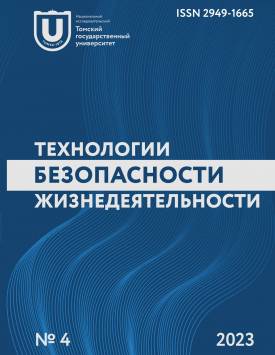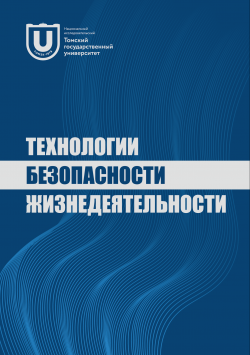Bactericidal activity of iodine-containing nanothermits
An important problem is the spread of viral aerosols and bacterial spores, the danger of which has been shown by the coronavirus pandemic. The biological hazard of such aerosols is beyond doubt, and the methods of combating them are still not effective enough. Halogen-containing reactive materials can be used to mitigate the spread of dangerous microorganisms. Iodine vapor is one of the most effective means for air disinfection in areas of high risk of infection. Their activity is manifested in the fact that iodine is able to destroy the bonds that hold proteins together in the cell and inhibit protein synthesis. To deactivate biogenic agents, we use a nanostructured thermite mixture based on aluminum nanoparticles, metal oxide (calcium, manganese or iron) and containing an iodine preparation. The novelty of the work lies in the use of metal nanoparticles, since an increase in the dispersion of thermite powder particles leads to an increase in the combustion rate and an increase in the reactivity of the material. The aim of the work is to find the optimal composition of iodine-containing nanothermite, which has the highest microbicidal activity. We conducted a series of experiments to study the microbicidal activity of iodine-containing thermite systems in relation to the B-11948 strain of lactobacilli. A sample of the thermite mixture was burned in the volume of the experimental chamber with the formation of iodine vapor. After exposure in the chamber, lactobacilli were cultivated for 48 hours. We assessed microbicidal activity by counting colonies on a microbiological counter. We found that samples with iodoform (CHI3) content of more than 30% have high microbicidal activity (more than 50 %). Microbicidal activity also depends on the composition of the nanothermite. The compositions with CuO-Al create the best iodine cloud. Thermite mixtures based on iron oxide showed the least microbicidal activity; in addition, such thermite mixtures did not always ignite. In the future, we plan to continue work on improving the compositions of nanothermite iodine-containing mixtures to neutralize infectious aerosols in the air. The authors declare no conflicts of interests.
Keywords
nanothermite,
microbicidal activity,
iodineAuthors
| Gaenko Olga I. | Institute for Problems of Chemical and Energetic Technologies of the Siberian Branch of the Russian Academy of Sciences | yuu-95@mail.ru |
| Muravlev Eugene V. | Institute for Problems of Chemical and Energetic Technologies of the Siberian Branch of the Russian Academy of Sciences | evvimv@gmail.com |
| Konyukhov Ilya E. | Institute for Problems of Chemical and Energetic Technologies of the Siberian Branch of the Russian Academy of Sciences | ilyakon008@gmail.com |
| Titov Sergey S. | Institute for Problems of Chemical and Energetic Technologies of the Siberian Branch of the Russian Academy of Sciences | titov.sergey.s@gmail.com |
| Klimenko Victor A. | Institute for Problems of Chemical and Energetic Technologies of the Siberian Branch of the Russian Academy of Sciences | klimenko@siberia.design.ru |
| Kudryashova Olga B. | Institute for Problems of Chemical and Energetic Technologies of the Siberian Branch of the Russian Academy of Sciences; Tomsk State University | olgakudr@inbox.ru |
Всего: 6
References
Stevenson A., Freeman J., Jermy M., Chen J. Airborne transmission: a new paradigm with major implications for infection control and public health // The New Zealand Medical Journal. 2023. Vol. 136 (1570). P. 69-77.
Борисевич С.В., Сизикова Т.Е., Сыромятникова С.И., Пантюхов В.Б., Лебедев В.Н. Некоторые опасные и особо опасные эмерджентные вирусные инфекции начала XXI века: возникновение, распространение, опасность для здравоохранения // Вестник войск РХБ защиты. 2018. Т. 2, № 2. С. 61-69.
Baboli Z., Neisi N., Babaei A.A., Ahmadi M., Sorooshian A., Birgani Y.T., Goudarzi G. On the airborne transmission of SARS-CoV-2 and relationship with indoor conditions at a hospital // Atmospheric Environment. 2021. Vol. 261. Art. no. 118563. P. 1-10. doi: 10.1016/j.atmosenv.2021.118563.
Paton D.J., Gubbins S., King D.P. Understanding the transmission of foot-and-mouth disease virus at different scales // Current opinion in virology. 2018. Vol. 28. P. 85-91. doi: 10.1016/j.coviro.2017.11.013.
Ollis D.F., Al-Ekabi H. (Eds.). Photocatalytic Purification of Water and Air. Amsterdam : Elsevier, 1993. 432 p.
Xu M., Huang N., Xiao Z., Lu Z. Photoexcited TiO2 nanoparticles through OH-radicals induced malignant cells to necrosis // Supra-molecular Science. 1998. Vol. 5 (5-6). P. 449-451. doi: 10.1016/S0968-5677(98)00048-0.
Hay S.O., Obee T., Luo Z., Jiang T., Meng Y., He J., Murphy S.C., Suib S. The viability of photocatalysis for air purification // Molecules. 2015. Vol. 20 (1). P. 1319-1356. doi: 10.3390/molecules20011319.
Бакина О.В., Глазкова Е.А., Сваровская Н.В., Волков А.М., Ворожцов А.Б., Лернер М.И. Электровзрывной синтез наночастиц ZnO-Ag с высокой антибактериальной активностью // Технологии безопасности жизнедеятельности. 2023. № 1. С. 82-90. doi: 10.17223/7783494/1/11.
Luo H., Zhong L. Ultraviolet germicidal irradiation (UVGI) for induct airborne bioaerosol disinfection: Review and analysis of design factors // Building and environment. 2021. Vol. 197. Art. no. 107852. P. 1-14. doi: 10.1016/j.buildenv.2021.107852.
Boyce J.M. Modern technologies for improving cleaning and disinfection of environmental surfaces in hospitals // Antimicrobial Resistance & Infection Control. 2016. Vol. 5 (1). P. 1-10. doi: 10.1186/s13756-016-0111-x.
Суворин Д.А., Жуйков Н.Н., Смирнова С.С., Краюхин Д.В., Кожарская Г.В., Поплавских С.Ю. Аэрозольная дезинфекция в системе противоэпидемических (профилактических) мероприятий в медицинских организациях // Контроль и профилактика инфекций, связанных с оказанием медицинской помощи (ИСМП-2021). 2021. С. 118-119.
Reverberi A.P., Meshalkin V.P., Butusov O.B., Chistyakova T.B., Ferretti M., Cardinale A. M., Fabiano B. Organic and inorganic biocidal energetic materials for agent defeat weapons: An overview and research perspectives // Energies. 2023. Vol. 16 (2). Art. no. 675. P. 1-26. doi: 10.3390/en16020675.
Abraham A., Schoenitz M., Dreizin E.L. Metal-based reactive materials with biocidal reaction products // Particle Technology Forum 2013-Core Programming Area at the 2013 AIChE Annual Meeting: Global Challenges for Engineering a Sustainable Future. AIChE. 2013. P. 441-442.
Лобанов С.М. Дезинфекция объектов животноводства препаратами на основе йода : дис.. канд. биолог. наук. М., 2001. 114 с.
Фокин А.И., Петрова А.А. Разработка новых эффективных методов дезинфекции (санации) воздуха и поверхностей объектов ветеринарного надзора препаратом газообразного йода // Птицеводство. 2019. № 6. С. 56-60. doi: 10.33845/0033-3239-2019-68-6-52-55.
Sanders V.E., Asay B.W., Foley T.J., Tappan B.C., Pacheco A.N., Son S.F. Reaction Propagation of Four Nanoscale Energetic Composites (Al/MoO3, Al/WO3, Al/CuO, and Bi2O3) // Journal of Propulsion and Power. 2007. Vol. 23 (4). P. 707-714. doi: 10.2514/1.26089.
Piercey D.G., Klapoetke T.M. Nanoscale aluminum-metal oxide (thermite) reactions for application in energetic materials // Central European Journal of Energetic Materials. 2010. Vol. 7 (2). P. 115-129.
Кудряшова О.Б., Торопков Н.Е., Лернер М.И. Реакционная способность нанотермитов при зажигании горячим телом // Южно-Сибирский научный вестник. 2023. № 2. С. 87-92. doi: 10.25699/SSSB.2023.48.2.006.

